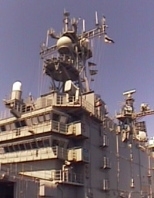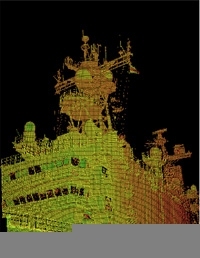Every year, the Navy conducts "shipchecks" in which surveyors gather detailed data about a vessel's structure to create computer models of the ship. Design engineers then use the models to plan renovations.
Now a new device developed by MIT engineers and colleagues is making shipchecks and surveys of other large, complicated structures faster and cheaper. In a shipcheck of the USS Tarawa, the device "collected much more information than required by a shipcheck -- in one-third the time such a process typically takes," according to its developers.
In another pilot study the device, dubbed CyraxTM, surveyed three oil field facilities acquired by Chevron. The company needed these surveys because it is expanding the facilities and there was no documentation from which to create the computer models necessary for the renovations.
As a result of the study, according to the Cyrax developers, "Chevron estimates that Cyrax can save the company 30 to 40 percent in the modeling process and cut field surveying from several months to a few weeks" for other facilities it owns.
Cyrax acquires 3-D data points for the structure in question and then turns those points into 3-D computer models. It is the only surveying instrument that can combine these processes and can produce a finished model in the field. The model can also be exported to common 2-D and 3-D computer-aided design (CAD) programs. Among the device's other advantages: it can be operated by one person, and it doesn't require scaffolding or shutting down a plant (the laser it uses to scan a structure is safe to use around humans).
Cyrax, which has won a 1998 R&D 100 Award, grew out of a collaboration between MIT's Lincoln Laboratory, Cyra Technologies and Los Alamos National Laboratory. Ben Kacyra, CEO of Cyra Technologies, approached Lincoln engineers and asked if they could help him develop an instant 3-D camera. "Cyrax is the closest thing to it that we could come up with," said John J. Zayhowski, a member of the technical staff at Lincoln Lab.
The device works by scanning the object of interest with a laser. Some of the laser light hits the object and is bounced back to the transceiver, the device incorporating the laser and other hardware. By measuring the time it takes for the light to make this trip, Cyrax can determine the distance to the object. That information, plus the angle to the object, is used to construct the cloud of 3-D data points that ultimately results in a 3-D model.
Lincoln Lab engineers led by Dr. Zayhowski developed the transceiver and the new kind of laser it contains. "Coincidentally, we'd just invented the laser when Ben came to us with his request," he said. It proved to be key to the entire system.
Cyra Technologies developed the software that converts the laser data to 3-D models. The company also created the computer interface to the transceiver. Los Alamos built the timingchip, analogous to a stopwatch, that measures how long it takes for the laser light to leave and return to the transceiver.
Development of the new laser was funded at Lincoln Lab by the US government. Work on the transceiver was funded as part of a cooperative research and development agreement by Cyra Technologies, which has licensed the laser from MIT.
A version of this article appeared in MIT Tech Talk on September 16, 1998.









